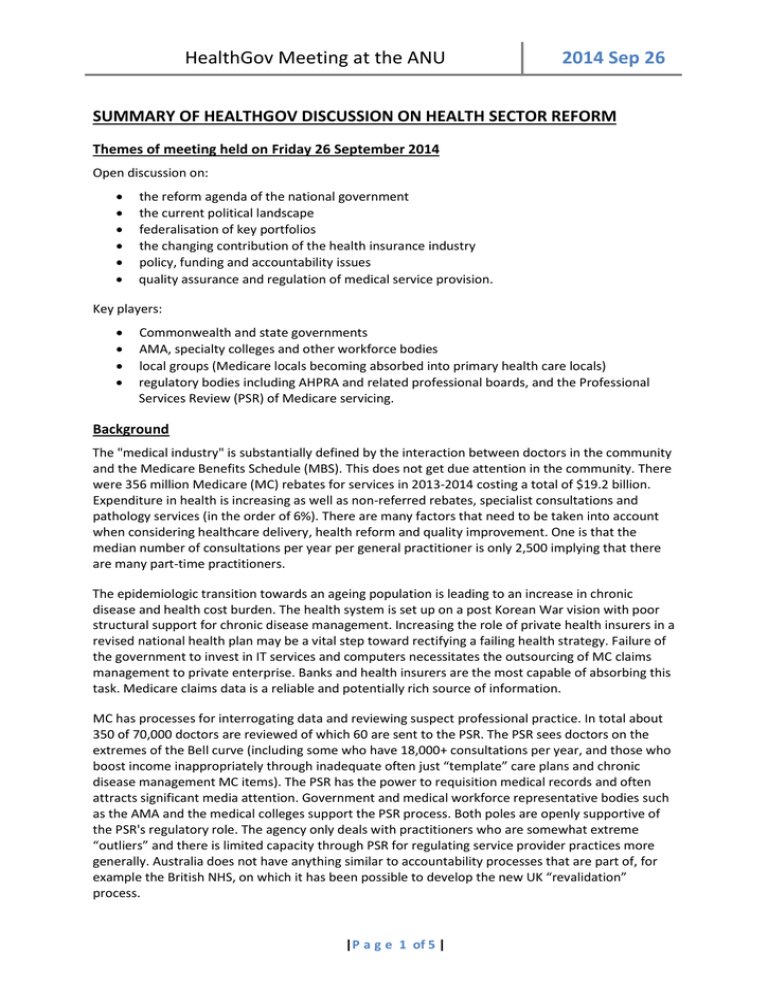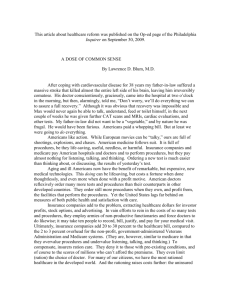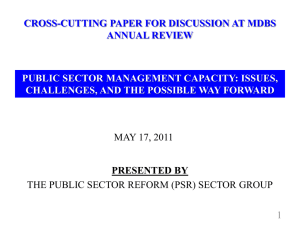HealthGov Meeting at the ANU 2014 Sep 26
advertisement

HealthGov Meeting at the ANU 2014 Sep 26 SUMMARY OF HEALTHGOV DISCUSSION ON HEALTH SECTOR REFORM Themes of meeting held on Friday 26 September 2014 Open discussion on: the reform agenda of the national government the current political landscape federalisation of key portfolios the changing contribution of the health insurance industry policy, funding and accountability issues quality assurance and regulation of medical service provision. Key players: Commonwealth and state governments AMA, specialty colleges and other workforce bodies local groups (Medicare locals becoming absorbed into primary health care locals) regulatory bodies including AHPRA and related professional boards, and the Professional Services Review (PSR) of Medicare servicing. Background The "medical industry" is substantially defined by the interaction between doctors in the community and the Medicare Benefits Schedule (MBS). This does not get due attention in the community. There were 356 million Medicare (MC) rebates for services in 2013-2014 costing a total of $19.2 billion. Expenditure in health is increasing as well as non-referred rebates, specialist consultations and pathology services (in the order of 6%). There are many factors that need to be taken into account when considering healthcare delivery, health reform and quality improvement. One is that the median number of consultations per year per general practitioner is only 2,500 implying that there are many part-time practitioners. The epidemiologic transition towards an ageing population is leading to an increase in chronic disease and health cost burden. The health system is set up on a post Korean War vision with poor structural support for chronic disease management. Increasing the role of private health insurers in a revised national health plan may be a vital step toward rectifying a failing health strategy. Failure of the government to invest in IT services and computers necessitates the outsourcing of MC claims management to private enterprise. Banks and health insurers are the most capable of absorbing this task. Medicare claims data is a reliable and potentially rich source of information. MC has processes for interrogating data and reviewing suspect professional practice. In total about 350 of 70,000 doctors are reviewed of which 60 are sent to the PSR. The PSR sees doctors on the extremes of the Bell curve (including some who have 18,000+ consultations per year, and those who boost income inappropriately through inadequate often just “template” care plans and chronic disease management MC items). The PSR has the power to requisition medical records and often attracts significant media attention. Government and medical workforce representative bodies such as the AMA and the medical colleges support the PSR process. Both poles are openly supportive of the PSR's regulatory role. The agency only deals with practitioners who are somewhat extreme “outliers” and there is limited capacity through PSR for regulating service provider practices more generally. Australia does not have anything similar to accountability processes that are part of, for example the British NHS, on which it has been possible to develop the new UK “revalidation” process. |P a g e 1 of 5 | HealthGov Meeting at the ANU 2014 Sep 26 Evolution of medical practice models Currently GPs are moving into niche practices and there is corporatisation of healthcare delivery. This has occurred in radiology and pathology services and is a more recent phenomenon in other settings. This evolution was not foreseen by previous governments and must be considered in future projections. In recent years there were numerous forms of consolidation within healthcare services: vertically integrated large medical practices (Primary Care) amalgamation of solo and small general practices and corporatisation of specialist practices (orthopaedics, ophthalmology, with likely involvement of cardiology and oncology specialties in the future). The political landscape The first Federal Budget under the current administration reduced significant Commonwealth funding from State and Territory health budgets. The Federal Budget will continue to be under pressure and the Government will be seeking ways to ensure spending remains prudent. Currently the Federal government is considering the nature of the Australian Federation with a view to clarifying and redefining the roles of each level of government. Inevitably this will impact on the health sector and significant reforms are anticipated. Green and White Papers are due to be released at the end of 2014 on health, education, housing and homelessness, and federal financial relations (https://federation.dpmc.gov.au/) The political spiel around the release relates to reduced waste and duplication, improved efficiency and productivity, increased economic growth, and simplified clearer governmental processes (link to scoping paper: https://federation.dpmc.gov.au/sites/default/files/issuespaper/issues_paper1_a_federation_for_our_future.pdf). There does not appear to be ongoing public dialogue regarding the proposed changes despite the government officially calling for wide stakeholder input. Health sector reform is best when there is bipartisan support. Not much is passed without this. Debate and political point-scoring can still occur around the edges as long as there is agreement on the core issues. The changing contribution of the health insurance industry Whilst there are various effective healthcare policies in operation in Australia, they have failed to stem the flow of people moving from early disease to acute care. Chronic diseases require a different style of management. A single payer system is an effective option for optimising current complexities in healthcare administration and in maintaining equity. There is room for a universal private insurance strategy to supplement shortfalls in publicly allocated services. An OECD report on citizen satisfaction rates for assorted health systems rated Australians as happy with their health but not their health system. The Dutch were the happiest of all with their health system. Dutch healthcare is an example par excellence of a blended social-private health system. The 2006 Dutch Healthcare Act scrapped the division between Social Health Insurance and Private Health Insurance creating a universally compulsory Social health Insurance scheme that is acclaimed internationally. Instead of being managed primarily by the government it is now the private health insurance market which is responsible for providing the basic package of health insurance to all citizens. Government top-up finance schemes maintain universality of care and provide a safety net for illegal immigrants (as covered in the following article: https://www.civitas.org.uk/nhs/download/netherlands.pdf). The main benefits of such a scheme include: |P a g e 2 of 5 | HealthGov Meeting at the ANU 2014 Sep 26 Oversight of the end to end healthcare of individuals. Ensuring investigations and pathology are conducted once, in a timely fashion, and without duplication. Consumers can choose care from a group of providers without disrupting universal coverage. It removes the distinction between primary health care and community health care. A similar system in Australia under the auspices of Medicare Select is a considered option for addressing forecasted population needs. However fund management is best devolved away from the guardianship of GPs (as practiced in the UK and New Zealand): GPs are not inherently skilled for managing funds from others; they are often too busy for this task; 70,000 individual fund holders can only create further fragmentation and inefficiencies; and there is a danger of welfare dependence of doctors on MC. Quality improvement (QI) of health services and professional practice There are no institutional or governance arrangements to ensure systematic ongoing quality assurance of health service provision especially in out of hospital care. As for other fields there is an ongoing tension between quality (of care) and economics. There are no measurements for quality, only dollars can be measured. Unfortunately quality practice will be first to fall when sided against productivity issues and raw financial concerns. Financial incentives can be a hindrance or an enabler of quality improvement activity. There is also a division of responsibilities among regulatory bodies with one set of powers for one group being offset by the powers for another group. In addition regulatory processes are strongly in favour of the health provider and not the consumer, a fact that is overlooked by government despite investment of significant funds toward safe health practice. Consequently it is questionable if the government is a good steward of taxpayer funds in this regard and if it adequately addresses public protection. The question of what constitutes best practice is not static and the responses change over time. Great value can be derived from reading Jerome Groopman's article: “Health Care: Who Knows 'Best'?”. The author questions the ability of doctors and administrators to do the right thing by patients if best practice falls outside the bounds of established guidelines. He questions to what extent should doctors be autonomous? (Book review link: https://www.nybooks.com/articles/archives/2010/apr/08/health-care-who-knows-best-2/) A concept to throw in the mix is that of "overdiagnosis". This is gaining much attention as the sold-out "Preventing Overdiagnosis" annual Conference can attest, which was held in Oxford just 10 days ago (link: http://www.preventingoverdiagnosis.net/). In this movement staple axioms are revisited: “Does frequency of care lead to quality of care?” “Does early diagnosis of conditions such as pre-diabetes or prostate cancer lead to better outcomes?” Another contemporary phenomenon that needs to be covered is speculative imaging. Does the commercialisation of MRIs and full body scans lead to timely interventions or a "happy crisis and merry new fear?" Do we let it all rip or place restrictions on this evolution? Regarding specialist services, training pathways among specialty colleges are reasonable but governance processes are not focused on sustaining quality care. In terms of regulation, colleges have enormous power - if they expel you they restrict your MC entitlements. This is not an option that is often used because of vested interest in their members. The main restriction placed by colleges is initial entry into the specialist ranks. Colleges do not adequately self-manage despite the expectations of government. This is because they either protect their own or are fearful of |P a g e 3 of 5 | HealthGov Meeting at the ANU 2014 Sep 26 antidiscrimination laws. This is most avidly demonstrated through the plight of whistleblowers following their disclosure, and the protectionism of the subject of criticism. Peer review and other QI activities appear to be ineffectual. The drive for continual quality improvement appears lost. The focus appears to be on individuals and not organisations. Transgressors of professional standards are not generally held to account. There are no accreditation standards for specialist practices with the exception of radiology, pathology and general practices. RACGP audit requirement are generally done haphazardly without ongoing follow-up and consequence. Accreditation of general practices and the GP Collaboratives has had questionable impact on overall quality care in Australian general practice. The shift to the 10 National Safety and Quality Health Service (NSQHS) standards by the Australian Council of Healthcare Standards (ACHS) has disrupted the evolution of previous standards. The pass/fail assessment format of the newly introduced ISO 9000 standards loses the systems focus, quality measures, and richness of the EQuIP criteria. In terms of Medicare-related practices the PSR is restricted in scope –about 15% of practitioners referred to PSR are referred on the Medical Boards. There is limited scope to stop people practicing or to appoint mentors or require retraining in areas of deficiency. Current MBS policy passively tries to “nudge” people into ideal behaviour just as absence of trays in cafeterias tries to restrict food intake. Options for enhancing QI and adherence to best-practice principles include: Reviewing the MBS and removing items that are no longer clinically appropriate. Constructing MBS items under choice architecture methodology that focus on quality benchmarks and practices. Ensure MBS items allow for identification and evaluation of quality of care. Utilising Medicare and PBS data to analyse prescription and referral patterns of GPs to identify aberrant practices (e.g. over-prescription, unnecessary referrals to specialists etc.). However caution is required in interpreting numbers alone, as they may not reflect medical practices biased by a load of complex patients. Employing registries for self-reporting, complaints and benchmarking. Strengthening the role of Colleges for setting professional standards and fostering quality assurance. Granting greater power to the director of PSR and therefore change service provider behaviours with the threat of substantive action. Introducing legislation to enhance co-operation and integration between professional boards, conduct regulators and the PSR. Investing in a quality assurance body similar to the UK Care Quality Commission, which regulates a range of facilities and general practices (https://www.cqc.org.uk/). A crosscutting Australian Commission on Safety and Quality in Health Care could fulfil this role (http://www.safetyandquality.gov.au/). The AMA also has a role in promoting professional values and standards. The threat of litigation may be a more tangible and direct approach to addressing substandard practices as it influences professional thinking and behaviour to a variable degree. Compulsory education and training by professional indemnity associations may be another avenue for enhancing adherence to quality practice. |P a g e 4 of 5 | HealthGov Meeting at the ANU 2014 Sep 26 Health governance objective of "defragging the system" There is a disjunction between the rhetoric of “high quality care” and reality. The MBS structure is not conducive to streamlined care. There are many silos of healthcare provision in Australia which result in fragmented and poorly integrated services and foreseeable inefficiencies and poor outcomes. There is a great need to "defrag the system". This can be accomplished through a review of federalism and creation of a single payer system. The National Health and Hospitals Reform Commission (NHHRC) addresses this through the melding of MC entitlements with health insurance add-ons (link to document summary: http://www.health.gov.au/internet/nhhrc/publishing.nsf/Content/1AFDEAF1FB76A1D8CA2 57600000B5BE2/$File/EXEC_SUMMARY.pdf). Government leadership is crucial for harmonising service provision. In particular clear guidance and articulation of the roles and expectations of the new Primary Health Networks is needed particularly in regards to their interaction with Local Health Districts. Role of technology and the PCEHR The Personally Controlled Electronic Health Record is an initiative doomed to fail from the outset. Research in the past has consistently shown that such a scheme is not viable. It is of no consequence if participation in the scheme is opt-in or opt-out. Issues relate to: arbitrary, incomplete and voluntary record-keeping dealing with incomplete information is particularly dangerous. The government must make the call to end this before it is fully implemented. Very wealthy companies like Apple and Microsoft are doing the same task for us at no cost to the public. They already have programs that manage patient health information. These and other evolving programs could be easily used by the government and be more accepted by the public because of their familiarity and versatility. (See Dr Chrono - Apple Electronic Health Records: https://www.drchrono.com/). Chronic disease management in the home Many of the activities performed in hospital can now be conducted from the home. These include: monitoring of blood pressure, oxygen saturation and other nursing observations administration of injections, IV fluids, and other treatments blood testing and transport for imaging. Hospital admissions tend to be long, expensive, disorientating and isolate patients from established networks of social supports particularly for the elderly. There is technological capacity for home telemonitoring and community services can assist with house calls. There are indisputable benefits for quality of life when community based care is undertaken. Community health must be amalgamated with primary health care for healthcare to meet the needs of the demographic shift. Multidisciplinary technically-enabled community teams will be able to offer monitoring and intricate tailored care for the complex patients of tomorrow’s society. |P a g e 5 of 5 |





